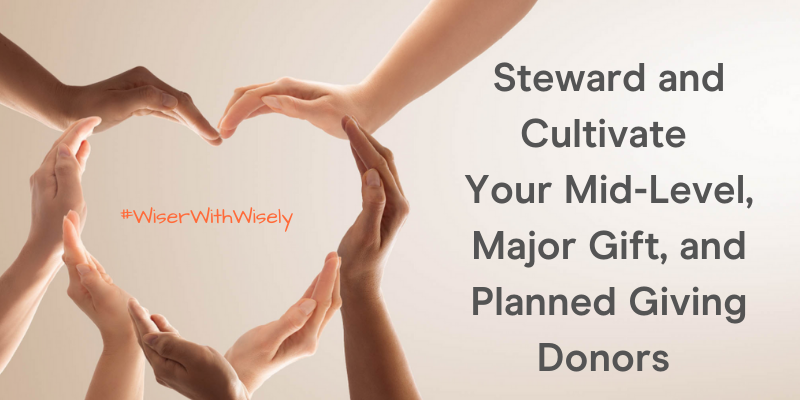
Every week #WiserWithWisely, Wisely’s Blog, brings to you a topic that’ll help your fundraising journey. This week we talk about how your fundraising team needs to build meaningful relationships with your donors through cultivation and stewardship. Your nonprofit’s fundraising team has many different donor types in their fundraising portfolio and each of these donor types has a different donor lifecycle and different needs. In this post, we will cover how to cultivate long-lasting relationships with your Mid-Level, Major Gifts, and Planned Giving donors.
If you need a refresher on the different donor types, check out this post: Nonprofit Donor Types and Ways to Communicate With Them
Mid-level Donors
In the hierarchy of your fundraising portfolio, mid-level donors sit between your annual giving donors and your major gift donors. They are making a higher than average contribution to your nonprofit, but they aren’t quite at the major gift level…yet.
How to cultivate and steward mid-level donors
As your fundraising team has a less personal relationship with mid-level donors than they would have with a major donor, cultivating and stewarding mid-level donors are best done on a mass scale. But that doesn’t mean you can’t weave in personal touches.
Here are a few ideas your fundraising team can action to build relationships with mid-level donors:
- Handwritten notes added to mass mail packages from the donor’s relationship manager. These can be additional pieces of paper included in the package or even handwritten notes in the letter’s margin.
- Special event opportunities, which can also be done virtually, for mid-level donors to engage with your nonprofit and fundraising team. For example, a talk from an expert in your nonprofit’s work, a beneficiary testimony, or a meet and greet with your nonprofit’s CEO.
- Phone calls are a great way to cultivate mid-level donor relationships and thank donors for their gifts. Set a goal each week to make a certain number of calls to mid-level donors so the number isn’t overwhelming.
- Mid-level impact reports in addition to mail solicitation to provide mid-level donors with a special “inside look” at your nonprofit’s work – and how their donation is helping!
Major Gift Donors
Cultivating and stewarding major gift donors and prospects can lead to larger and larger donations and pledges over time, including securing a legacy or planned gift from these donors. Building meaningful relationships is very important for donors to feel involved in the mission to continue giving year on year and to build donor retention.
How to cultivate and steward major gift donors
Your nonprofit’s relationship with major donors is very personal, so that means your cultivation and stewardship tactics have to be personal as well. But that doesn’t mean you have to rely solely on phone calls and meetings to cultivate and steward major donors.
Here are a few ideas your fundraising team can action to build relationships with major donors, outside of the typical phone calls and lunch meetings:
- Share new updates and campaigns. Just because your major gift donors are not giving to your annual campaigns doesn’t mean they wouldn’t be interested in the content. Try forwarding a major gift donor an email from your latest online fundraising campaign just as an FYI.
- Insider updates on program launches and mission successes. Did you recently launch a really successful program? Share it with your major donors so they can see your work in action even if that’s not specifically what they donated to.
- Small scale special events just for major gift donors featuring your staff or an expert speaker talking about your nonprofit’s mission in detail so they feel like they are part of your nonprofit’s work – these can even be done virtually!
Planned Giving Donors
Planned giving donors are similar to major donors in that your fundraising team’s relationship with these individuals is very personal. However, unlike major donors, most planned giving donors are leaving legacy gifts that will be made after they pass.
How to cultivate and steward planned giving donors
Seeing as planned giving donors are making gifts that will be realized after they have passed, cultivation and stewardship is an ongoing process throughout, and after a donor’s life. And remember, just because they have committed to a planned gift doesn’t mean they won’t continue to give smaller gifts during their lifetime.
Here are a few ideas your fundraising team can action to build relationships with your planned giving donors:
- Get to know the family of your planned giving donors, you can’t steward the donor after they have passed, but you can continue to demonstrate impact to their family who may want to continue to support your nonprofit.
- Use handwritten notes to give your planned giving donors special treatment, especially if you’re going to continue to include them in mass communications.
- Host small events just for planned giving donors and prospects that focus on your nonprofit’s work and the importance of legacy and planned gifts.
- Involve them in your work! Planned giving donors make great ambassadors for your nonprofit that can give a short quote or testimony about the impact of your work.
This past month we’ve spoken about how to cultivate and steward your donors to build long-lasting meaningful donor relationships. Throughout the series moves management has been mentioned quite a bit. In the coming weeks, we’ll be discussing moves management in more detail, what it is, why it’s important, and how Wisely can help your fundraising team manage the process.
Click on the link below to watch Wisely in Action 🙂
